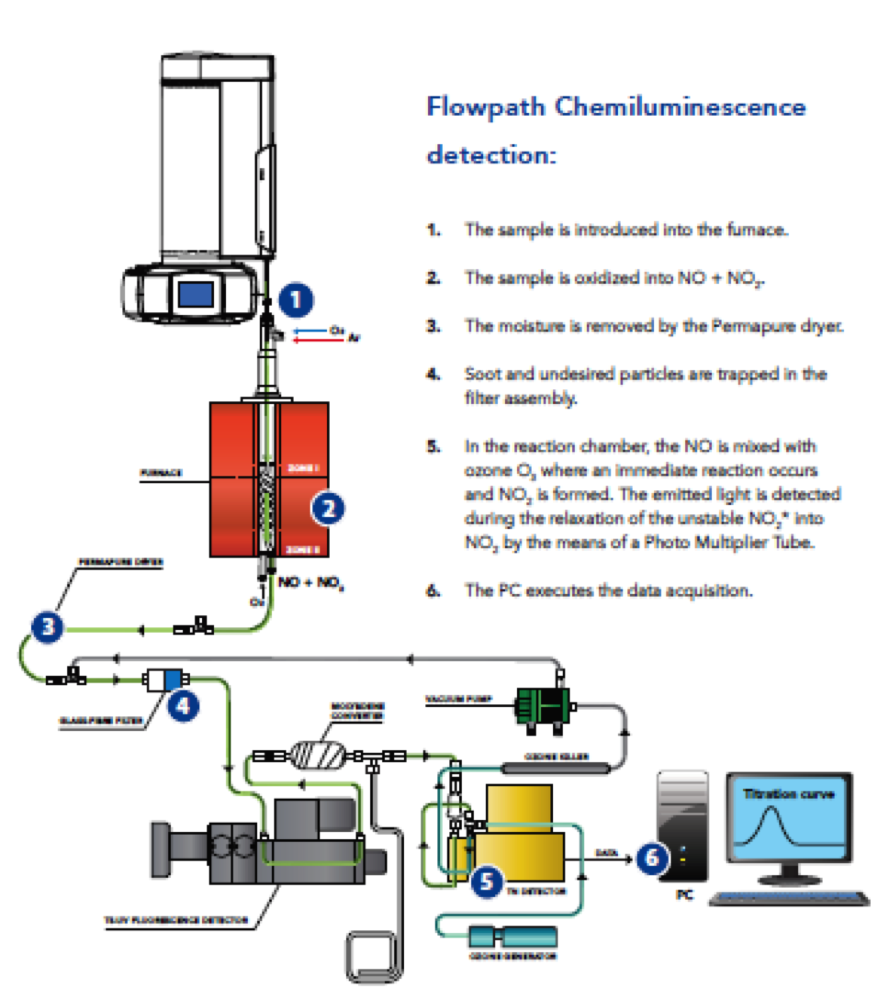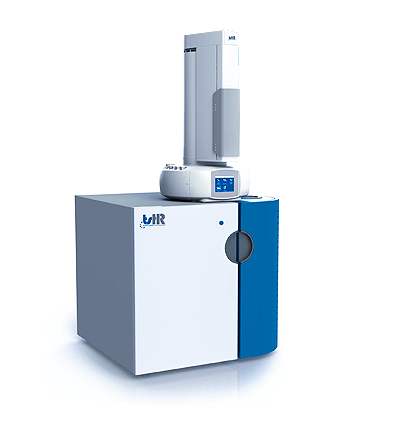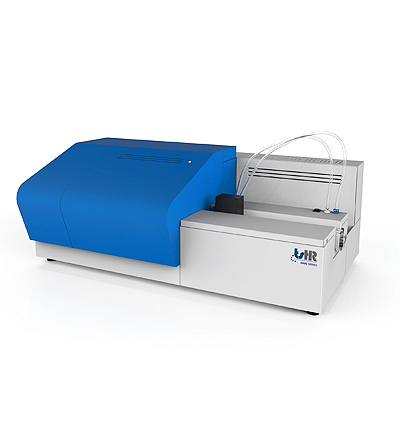ASTM D7184
Standard Test Method for Ultra Low Nitrogen in Aromatic Hydrocarbons by Oxidative Combustion and Reduced Pressure Nitrogen Chemiluminescence Detection
D7184 provides the required sensitivity for the reliable determination of ultra low nitrogen content in pure hydrocarbons. The controlled and complete combustion of the sample convert all bound nitrogen compounds in nitrogen oxide. The method takes advantage that NO reacts fast and quantitatively with O3 forming an excited NO2* that releases its excess energy captured by a PMT which has been set at the Red/NIR region. The envelop of energies released by the relaxation of NO2* lies in the 600 – 2300 nm region with a maximum value around 1000 nm. It was found that the sensitivity greatly increases at low temperature and reduced pressures. In these conditions a high population of O3 molecules is preserved and the collisions of NO2* losing their energy before it chemiluminesces are significantly reduced. Nitrogen although scarce in aromatic hydrocarbons its determination is gaining importance due to several factors: It degrades the activity of expensive catalysts especially platinum based ones used in conversion processes like reforming and isomerization, equally important is the synthesis of polymers where they seriously affect the activity and selectivity of the catalysts. TSHR TN7000 analyzer guarantees precise, and accurate experimental results. The system meets with great ease the required LOQ of the method scope”. (Aaron Mendez Ph.D.)
Method Summary:
A measured specimen is introduced into a carrier gas stream, at a controlled rate by an automatic syringe sample changer and incorporated into a high temperature furnace (900 to 1150 °C) were an excess of pure oxygen is added. Pyrolysis converts hydrocarbons in the specimen to CO2 and H2O. Organic and inorganic nitrogen compounds present in the sample are converted into nitric oxide (NO). After the gases exit the combustion zone they are passed through a semipermeable Nafion® membrane dryer where the water is quantitatively removed. The gases pass through a Mo convertor where NO2 molecules in case they form will be reduced to NO to enhance the detector signal. The gases enter the Nitrogen reaction chamber where they are mixed with a stream of O3 to produce an excited NO2* species. The NO2* molecules upon relaxation release an amount of energy proportional to the N original concentration. The relaxation takes a few nanoseconds and the energy captured by a Photo Multiplier Tube, is amplified processed and recorded. The signal obtained is proportional to the total nitrogen content of the original sample. Operating the detector at reduced pressure lowers the possibility of losing signal intensity due to the loss of excited NO2* by collisions with other molecules before chemiluminescence enhancing therefore the signal to noise ratio.
Apparatus
The analyzer of vertical configuration for volatile organic compounds is represented in fig.1. The system is provided with an automatic sample changer and a vaporization inlet system 1; a dual zone combustion furnace 2; the membrane dryer 3; a precautionary particle filter 4; the O3 source and reaction and detector module 5; and the signal acquisition and processing unit 6. The difference to the system described in D4629 lies in the use of the vacuum pump to reduce the reaction cell pressure to achieve the required LOQ.
Test Procedure:
Apparatus preparation and calibration: Once the system has been assembled, leak tested, heated and stabilized per the instrument manufacturer, typical operating conditions D4629 are stablished and adjusted as per the manufacturer’s guidelines.
The fact that the characteristics of equimolarity and linear response any organic compound containing at least one bound atom of N can serve as a calibration compound and the calibration can proceed with a minimum of three points. Based on anticipated nitrogen concentrations needs the instrument is then calibrated either by dilution of a stock solution or using a calibration kit from commercial standard reference laboratories. Set the calibration method to average three consecutive injections for each calibration point. Check the linear regression coefficient of the obtained calibration curve and make the necessary corrections should the linearity not be in accordance with D4629 and the manufacturer’s instructions ( R2 ≥ 0.999 or 1 to 2 orders of magnitude for the calibration range). It is a good laboratory practice to start the calibration in ascending order to reduce risk of carryover that could affect the linearity of the calibration.
Analysis: Prepare a sequence of analysis for the samples to be analyzed under the same unaltered experimental conditions and again taking the average of three consecutive injections. Sulfur concentrations of the unknown samples should fall in the calibration range. Perform dilutions on gravimetric or volumetric basis if necessary. Measure the response of the system for the test solution and inspect the combustion tube and the flow tubing of the instrument after the sample analysis to verify complete combustion. Soot should not be detected. In case the soot formation is detected care should be taking by reducing sample size or rate of injection after cleaning the systems as per manufacturer’s instructions. Densities needed for the calculations are to be measured by ASTM Test Methods D1298 and D4052 at the test temperature.
Report
Report the nitrogen results as mg N/kg of the sample. Report to the nearest 0.01 mgN/kg. Repeatability—The difference between two test results obtained by the same operator with the same apparatus under constant operating conditions on identical test material would, in the long run, in the normal and correct operation of the test method, provide the following repeatability values: 0.006 at the 0.03 mg N/kg level and 0.06 at the 1 mg N/kg level. Reproducibility—The difference between two single and independent test results obtained by different operators working in different laboratories on identical test material would, in the long run, in the normal and correct operation of the test method, exceed the following values in only one case in twenty, where X = the average of the two test results.
Quality Assurance and Quality Control
Experimental values and QC/QA control samples should fall within the precision estimates of the method or comply with the general equations for r” and R” as described above. It is recommended to follow Guide D 6809 to help ensure the quality of data generated by this ASTM D7184 nitrogen chemiluminescence detection method.


